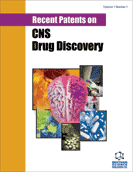Abstract
Zolpidem is a selective agonist of the benzodiazepine subtype receptor BZ1. The highest density of this receptor is in the output structures of the basal ganglia. The basal ganglia are pathologically involved in many movements disorders. Thus, zolpidem has accumulated attention for a possible drug to treat neurological signs and symptoms in Parkinsonian diseases. In this mini-review, I reviewed effects of zolpidem as movement disorders including Parkinsons disease, progressive supranuclear palsy, dystonia and so on. In addition, I reviewed a possible mechanism of zolpidem for movement disorders.
Keywords: Zolpidem, movement disorders, gamma-aminobutyric acid (GABA), Parkinson's disease, progressive supranuclear palsy (PSP)
Recent Patents on CNS Drug Discovery (Discontinued)
Title: Zolpidem Therapy for Movement Disorders
Volume: 3 Issue: 1
Author(s): Kazuo Abe
Affiliation:
Keywords: Zolpidem, movement disorders, gamma-aminobutyric acid (GABA), Parkinson's disease, progressive supranuclear palsy (PSP)
Abstract: Zolpidem is a selective agonist of the benzodiazepine subtype receptor BZ1. The highest density of this receptor is in the output structures of the basal ganglia. The basal ganglia are pathologically involved in many movements disorders. Thus, zolpidem has accumulated attention for a possible drug to treat neurological signs and symptoms in Parkinsonian diseases. In this mini-review, I reviewed effects of zolpidem as movement disorders including Parkinsons disease, progressive supranuclear palsy, dystonia and so on. In addition, I reviewed a possible mechanism of zolpidem for movement disorders.
Export Options
About this article
Cite this article as:
Abe Kazuo, Zolpidem Therapy for Movement Disorders, Recent Patents on CNS Drug Discovery (Discontinued) 2008; 3 (1) . https://dx.doi.org/10.2174/157488908783421519
| DOI https://dx.doi.org/10.2174/157488908783421519 |
Print ISSN 1574-8898 |
| Publisher Name Bentham Science Publisher |
Online ISSN 2212-3954 |
 36
36Related Articles
-
Patent Selections
Recent Patents on Biomedical Engineering (Discontinued) Bacterial Eukaryotic Type Serine-Threonine Protein Kinases: From Structural Biology to Targeted Anti-Infective Drug Design
Current Topics in Medicinal Chemistry Development of Inhibitors of the Aspartyl Protease Renin for the Treatment of Hypertension
Current Protein & Peptide Science Commentary (Changes of Synaptic Plasticity in Multiple Sclerosis)
CNS & Neurological Disorders - Drug Targets Pharmacological Treatments for Attention-Deficit/Hyperactivity Disorder (ADHD) in Adults
Current Psychiatry Reviews Rescuing Mutant CFTR: A Multi-task Approach to a Better Outcome in Treating Cystic Fibrosis
Current Pharmaceutical Design F508del-CFTR Rescue: A Matter of Cell Stress Response
Current Pharmaceutical Design Aquaporins as Targets for Drug Discovery
Current Pharmaceutical Design Molecular Methods for Individualization of Psychotropic Drug Treatment
Current Pharmacogenomics Editorial (Thematic Issue: Sleep and Psychiatry)
Current Psychiatry Reviews Recent Patents Regarding Essential Oils and the Significance of their Constituents in Human Health and Treatment
Recent Patents on Anti-Infective Drug Discovery Stem Cell-based Tissue Engineering Approaches for Musculoskeletal Regeneration
Current Pharmaceutical Design Protozoan HSP90-Heterocomplex: Molecular Interaction Network and Biological Significance
Current Protein & Peptide Science MicroRNAs: Modulators of Tooth Development
MicroRNA Human Defensins: Synthesis and Structural Properties
Current Pharmaceutical Design Clearance of Beta-Amyloid in the Brain
Current Medicinal Chemistry The Role of Mitochondrial Function in Glutamate-Dependent Metabolism in Neuronal Cells
Current Pharmaceutical Design Epileptic Time Series Prediction: A Patent Perspective
Recent Patents on Computer Science Commentary 1 (Research Highlights: Parkinson’s Disease and α-Synuclein: Passing it on)
CNS & Neurological Disorders - Drug Targets Abiotic Regulation: A Common Way for Proteins to Modulate their Functions
Current Protein & Peptide Science






















